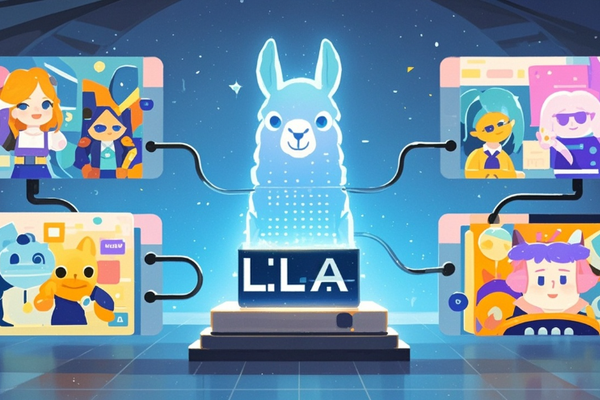LLaMA 4:开源模型的新方向
Meta recent release of LLaMA 4 has sparked wide interest, with some hailing it as Meta’s “open-source ace” against OpenAI’s GPT-4 and Anthropic’s Claude. But can LLaMA 4 truly live up to this title? What are its strengths and weaknesses? This article will delve into the technical features, market positioning, and future trends of LLaMA 4, aiming to provide some answers.
The Significance of Open Source: More Than Just Free
Open source, for large language models (LLMs), means more than just “free to use”. It represents transparency, customization, and community-driven development. Unlike proprietary models, open-source models allow developers to understand the inner workings of the model and make targeted optimizations and improvements. This openness not only accelerates technological innovation but also lowers the barrier to entry for LLM applications, enabling more people to participate in the AI revolution.
Meta’s decision to open-source LLaMA 4 is undoubtedly an attempt to harness the power of the community to drive LLM development. This stands in stark contrast to OpenAI and Anthropic, which favor model secrecy. Whether this open-source strategy can help LLaMA 4 stand out in the competitive landscape remains to be seen.
LLaMA 4’s Technical Highlights: Multimodal and Ultra-Long Context
Based on current information, LLaMA 4 boasts several notable technical features:
- True multimodal understanding: Reportedly, LLaMA 4 has achieved the ability to process text and images simultaneously, enabling it to understand and reason about content from both modalities. This multimodal capability opens up new possibilities for LLM applications, such as image description and visual question answering. Training involves processing up to 48 images at once, demonstrating LLaMA 4’s powerful multimodal processing capabilities.
- Ultra-long context window: Some sources mention LLaMA 4’s emphasis on ultra-long context windows. The context window refers to the amount of historical information a model can reference when generating text. Longer context windows allow models to better understand the semantics of long texts and generate more coherent, consistent content. This is crucial for tasks involving complex documents and long conversations.
- Mixture-of-Experts (MoE) mechanism: It has been reported that LLaMA 4 employs the MoE architecture. MoE consists of multiple “expert” models, each specializing in different tasks or data. During each forward pass, only a subset of expert models is activated, reducing computational overhead and improving model efficiency.
These technical highlights suggest that LLaMA 4 has made breakthroughs in multimodal understanding, long-text processing, and computational efficiency. However, whether these advantages can translate into practical value remains to be seen.
LLaMA 4’s Challenges: Code Generation and Training Controversies
Despite the hype surrounding LLaMA 4, it also faces several challenges:
- Code generation needs improvement: Evaluations show that LLaMA 4’s code generation capabilities lag behind GPT-4. Code generation is a crucial indicator of an LLM’s practicality. If LLaMA 4 has weaknesses in this area, it may limit its applications in software development and other fields.
- Training controversy: Some reports hint at potential issues with LLaMA 4’s training process. While the specifics are unclear, if LLaMA 4 is indeed guilty of training “cheating,” it could severely damage its reputation and erode user trust.
These challenges serve as reminders that we should approach LLaMA 4 with caution and objectivity. We should neither be overly optimistic nor dismissive.
Open-Source Ace or Another Open-Source Possibility?
Can LLaMA 4 truly become the “open-source ace” against GPT-4 and Claude? It’s too early to tell.
On one hand, LLaMA 4 has advantages in multimodal understanding, ultra-long context windows, and open-source strategy. On the other hand, LLaMA 4 may have weaknesses in code generation and training data, which could impact its competitiveness.
Moreover, the competition in LLM space is dynamic. GPT-4 and Claude are continually evolving, and new models and technologies are emerging rapidly. LLaMA 4 must innovate continuously to maintain its leading position.
Rather than labeling LLaMA 4 as the “open-source ace,” it might be more accurate to view it as an open-source LLM’s new possibility. It represents Meta’s exploration of the open-source model and offers developers more choices.
Looking Ahead: Community-Driven Possibilities
The future of LLaMA 4 largely depends on community participation and contributions. Open-source models’ success hinges on the collective intelligence of global developers.
If LLaMA 4 can attract a large and active community, it has the potential to overcome its current challenges and achieve greater breakthroughs. Conversely, without community support, LLaMA 4’s development may be limited.
In conclusion, LLaMA 4’s release has injected new energy into the LLM landscape. It is not only Meta’s attempt to compete with OpenAI and Anthropic but also an exploration of the open-source model. Regardless of LLaMA 4’s ultimate outcome, it will leave valuable lessons and insights for LLM development. Let’s wait and see where the power of open source takes LLaMA 4.

